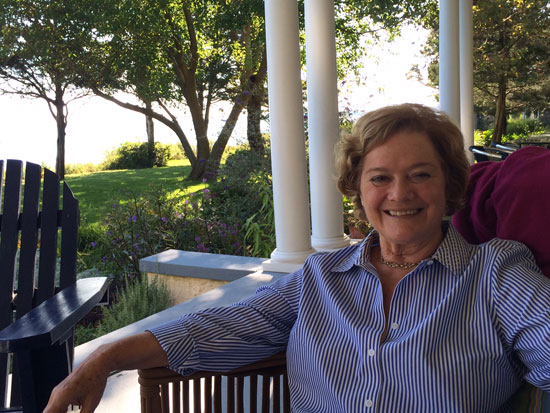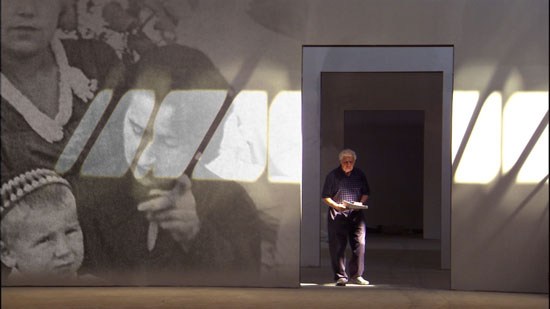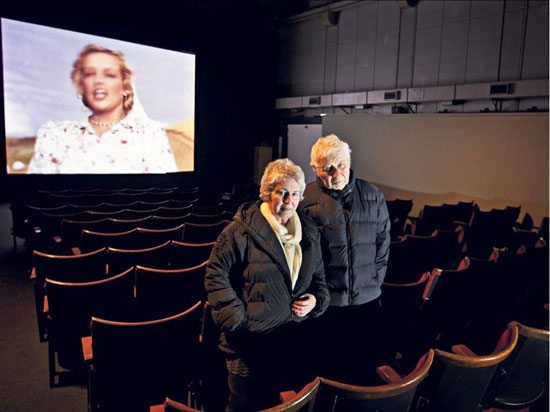For director Amei Wallach, the screening on September 26, 2014 of her film “Ilya and Emilia Kabakov: ENTER HERE” at the Parrish Art Museum—and the conversation with artist Emilia Kabakov that follows it—represents the culmination of a five-year transcontinental labor of love.
The program at the Parrish, which starts at 6 p.m., is also in some ways just one more way station on a path that she has been following ever since she gave up a short-lived interest in becoming an actress and devoted herself to writing, for many years as a journalist, almost always about the arts and in particular the visual arts.
It was on this path, a few years into her 26-year stint working for Newsday as a writer and art critic and her other job of writing television essays for Public Television’s “The MacNeil/Lehrer Report” that she met the artist Louise Bourgeois and then found her way into the world of documentary filmmaking.
Filmed from 1993 to 2007, “Louise Bourgeois: The Spider, The Mistress and the Tangerine” was co-directed by Marion Cojari, who died in 2006, and edited by Ken Kobland, with Kipjaz Savoie and George Griffin teaming up with Cajori and Wallach as producers.
In an interview at her North Fork home overlooking Peconic Bay in New Suffolk, N.Y. last week, Wallach talked about the experience of making a film about a legendary, groundbreaking artist and some of the discoveries she made along the way.
.

Writer and filmmaker Amei Wallach at her home in New Suffolk. Courtesy AB Photo.
.
“All these years of writing about art, it was a process of translating it into another language,” she said. “But art is visual, and film is a similar language. With film you can show art in a way that you can’t even see it in real life, especially sculpture and installation.”
“With film,” she continued, “you could tell the story and show the art in a way you couldn’t do with words.”
It was also on her path as a journalist and arts writer, a few years before she became a filmmaker, that she first encountered the internationally renowned Russian artists Ilya and Emilia Kabakov.
As she recalled in the interview, skepticism in the West in 1987 about Mikhail Gorbachev’s new glasnost policy of openness and transparency prompted editors at Newsday to send her to Moscow to see if reality matched the message.
“The way Gorbachev was getting the word out,” she said, “was by letting artists do things they’d never been permitted before—filmmakers, underground artists, the theater avant garde.”
Wallach’s trip and reporting became a five-part series starting on page one of Newsday’s Sunday Arts section on how the arts were changing in Russia.
One of the underground artists she met while in Moscow was Ilya Kabakov. Like other artists across all disciplines in Russia at that time, Kabokov was wrestling with an elemental question, Wallach said: “What were the conceptual tools by which you analyze your society and make art about it?”
His answer was to make installations that people could walk into, starting with large pieces—“almost theater flats,” Wallach said—that he put up against the wall or used to create walls bearing his art.
She first met and talked to Kabakov in September of 1987, she recalled. In October of that year he made his first trip to the West, and by 1988 he had his first show in New York and then went on to become what Wallach called “a major, major artist.”
It was in 1988, she said, that Paul Gottlieb, then the editor-in-chief of Harry N. Abrams, first suggested that she do a book on Kabakov. The jumping-off point for that book would come three years later in 1991, when Robert Storr, then the chief curator in the department of painting and sculpture at the Museum of Modern Art in New York, included Kabakov—alongside Louise Bourgeois, among others—in the “DISLOCATIONS” show at the museum.
In order to gather all the material for the book, Wallach, had to work around her full-time job at Newsday to “go to where it was.” That meant trips to Germany and Finland and other countries in Europe where Kabakov, in collaboration with his wife and partner, Emilia, had made his art and installations.
Wallach also interviewed the Kabakovs extensively during the early ’90s and invited them to her house in New Suffolk to facilitate the process. The couple fell in love with the area, started to rent on the North Fork, and by 1995 had bought a house and moved to the East End permanently.
“Ilya Kabakov: The Man Who Never Threw Anything Away”, with an introduction by Robert Storr, came out from Abrams in 1996. By that time, Wallach was already three years into the filming of the documentary she and Cajori and Kobland were making about Louise Bourgeois.
Fast forward to June of 2008, when the Kabakovs came to the first screening of the Bourgeois documentary at the Film Forum in New York. It was then, Wallach recalled, that Kabakov—who had sworn he would never return to Russia—informed her that he was accepting an invitation to go to Moscow in order to create a massive exhibition. She realized instantly that his epic enterprise would be the subject of her next film.
.

Ilya Kabokov in the Labyrinth Installation in Moscow. Photo courtesy www.kabakovfilm.com.
.
She quickly got Kobland and Savoie and cinematographer Mead Hunt, her partners on the Bourgeois film, on board and by July was over in Moscow filming Kabakov at work.
“It was a huge event,” Wallach said. People in Moscow were stunned to see the legendary artist in their midst, she said, because by the time he returned, “he had become a myth . . . ‘he does not exist.’”
The project had first been envisioned as the Kabakovs’ response to an invitation to inaugurate the Garage, a huge art space Dasha (Daria) Zhukova was creating out of a Moscow bus garage designed by the Constructivist architect Konstantin Melnikov in 1927. After accepting this commission, though, the couple enlarged the project to six installations in five venues, including the Pushkin Museum.
The kernel of the artistic impulse informing all of the installations, goes back to Kabakov’s original exploration of the conceptual tools for analyzing and holding a mirror up to society, in order to show the disconnect between the official state message of how things are supposed to be and the way they really are.
.

Artist Ilya Kabakov. Photo courtesy www.kabakovfilm.com.
.
She pointed to Robert Storr’s comments in “ENTER HERE” about the nature of Kabakov’s art. “He talks about how on the one hand there is the great Utopian dream and the freedom of the avant garde art of the teens,” she said, “and how the life that Kabakov was living did not match that dream in any way, and it’s in the gap between the two that Kabakov makes his art.”
The website for the documentary, www.kabakovfilm.com, includes in a section on the story of the film this quote from the artist himself:
“My mentality is Soviet, but it is irony. Irony. The Soviet mentality is also the old European. It is like a sandwich, because the education in the Soviet is beautiful. And the mentality is like a sandwich of the classical European education, reflections of Soviet ideas, and dreams of Western art. What I say is ironical. It is not possible for me to talk real. The real for me is idiotic. I’m Soviet, I’m Russian, and it is not possible to talk simply. That is stupid. Irony is a reflection about life. You can never talk in a real way about this. If you talk simple, it is not a sandwich, but bread. That is a catastrophe.”
For the centerpiece installation at the Garage, Kabakov created 25 rooms filled with paintings laid out as a mini-version of the Metropolitan Museum in New York, “to show the people in Moscow what a great museum should be,” Wallach said.
.

Ilya Kabakov in the Labyrinth installation in Moscow. Photo courtesy www.kabakovfilm.com.
.
In making the documentary, she had the camera go through the installation as a visitor would, stopping to look at and consider some of the paintings and passing quickly by some of the others. But she understands why Kabakov maintains that capturing an installation on film can’t be compared to experiencing it in person.
His idea in the installations he made in Moscow, she said, “is that he is creating these rooms inhabited by Soviet characters and you would understand their psychology and it would key into your own hopes and fears and disappointments. The viewer has an experience that is different from watching a film.”
And although he, unlike his wife, might have reservations about the documentary process, he was very cooperative during the filming and even made some valuable suggestions, Wallach said, after watching a three-and-a-half-hour rough cut.
.

Ilya and Emilia Kabokov. Photo courtesy www.kabakovfilm.com.
.
His rough-cut suggestions were particularly important, she said, because “it’s in taking things out that you actually create a film.”
She also made it clear that she understands the difference between experiencing a work of art and telling the story, in words and even on film, of who the artist is, how he or she made the art, and what the art is.
Being able to screen the film at the Parrish on Friday, she said, and having the great good fortune to be able to discuss it with Emilia Kabakov afterwards, all contribute to the fulfillment of her lifelong objectives.
“What I’ve tried to do as an art critic and in this film,” she said, “is give you so much context that you have a way to understand the art in a more complete way.”
BASIC FACTS: “Ilya and Emilia Kabakov: ENTER HERE” directed by Amei Wallach will screen on Friday, September 26, at 6 p.m. at the Parrish Art Museum. A discussion with Emilia Kabakov and Amei Wallach follows. The Parrish Art Museum is located at 279 Montauk Highway, Water Mill, NY 11976. www.parrishart.org.
For information on the documentary, visit www.kabakovfilm.com.
For information on the Kabakovs, visit www.ilya-emilia-kabakov.com.
_______________________________
Copyright 2014 Hamptons Art Hub LLC. All rights reserved.
